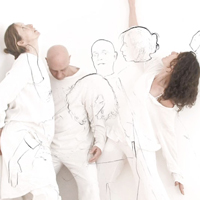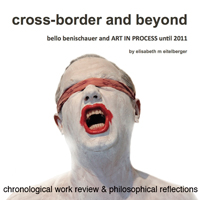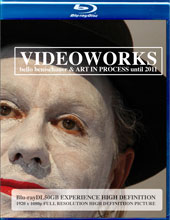CROSS-BORDER AND BEYOND
published through ISEA 2011 Istanbul
Globalisation has opened up enormous possibilities of linkages; it ideally means dissemination, diversity and insight into foreign worlds. But other than leading to a broad perspective and enthusiasm about the various aspects of this world per se and its cultures, we must admit that – critically observed – globalisation very often concludes in generalisation and uniformity (shaped and dominated by Western society and lifestyle). It has become the ideal platform for broad mainstream, a playground for unquestioned fast food and monopole society. For artists, in the contemporary context, globalisation can lead to the creation of diverse and specific interfaces, establishing new ways of communication and producing (collaborative) work that sets a counterpoint to the various absurd forms of mass consumption. This paper talks about the work by bello benischauer & elisabeth m eitelberger: ART IN PROCESS (AIP), an Australian/Austrian partnership that critically engages with a number of issues/behaviours specific to cross-cultures and consumer culture. [1]
We (AIP) develop our projects independently and in collaboration with other artists on the intersection of installation, video and performance art. Such hybrid productions, created in-between art genres of experimental dance and theatre, visual arts, music and performance art, are elsewhere referred to and summarised as Contemporary Performance. [2]
In our case we use new media/technology as a fusing and transmitting element to deliver and increase the transportation of an artistic message to a wider and global audience. Some of our video/sound installations that have been the result of recent project series (addressing the growing inter-human and artistic communication through interdisciplinarity) are exhibited during ISEA2011 (SUEX 2008, Intervention 2009 and Emotional Seasons 2010) and reflect most significantly the general nature of our work from the past decade. The exhibition and the workshop called Born to be a still life are accompanied by this theoretical presentation of our artistic practice. [3]
Within our work we often force an interaction with the public; increasingly through the use of performance art techniques, which allow us to reach a broader and non-selective audience; experimenting with the art’s functioning outside its traditional spaces. The filmed and photographed documentation of such acts of live performances in public or private space is then used in the further development of artistic projects to finally result in video/sound installations that again can be brought back into the exhibition space (and/or are screened online). Single projects, always consisting of multiple components, are developed during one-year-long periods.
The constant use of language(s) as a strong tool in this work, intends to make people aware of certain issues through sometimes-provocative voice works that lead the audiences out of their comfort zone into a confrontation with own, mostly unquestioned, behaviour patterns. While our work is not didactic it reflects and seizes contemporary issues in our society. In all this work we aim to explore relationships between the human being and its urban/natural environment in various socio-cultural contexts, generally addressing issues related to identity and belonging that arise from globalization and/or cultural structures. Single projects address an elimination of existing distances through borders and barriers between countries, cultures and individual people. We investigate selected spaces of collective and cultural identities through onsite projects (i.e. through AIRs) and promote art that extends into the social space, believing in the necessity of art that puts use over meaning.
bello benischauer, working as an artist for more than twenty years, went global with his projects on a regular basis since his formation of AIP with partner elisabeth m eitelberger, who is artistically involved and accompanies bello on a theoretical basis. Since the age of eighteen, bello became increasingly interested in a combined use of diverse artistic techniques, and finally set a special focus on new media – particularly video/sound installations – connecting visual images, spoken word and sound. bello spent ten years in South and Central America, Pakistan, Iran, Nepal, South and East Africa, Indonesia, New Zealand, India and many other places is Australia and Europe, which results today in a deep connection to world-cultures and led to a special interest in the world’s varied socio-cultural milieus. Travelling and the constant aim to connect to different cultures through its people, lead to the manifestation of bello’s ideas, realised within our projects. These ideas do not refer to particular theories but of course, are influenced by our immediate surroundings, by the media, by education and depending on and shaped by our own individual cultural heritage/history and its multifarious, social layers.
In becoming an extremely globalised world not only the western image of art has changed but also the exhibition space per se has died. Art lives now in cyberspace, it happens within the social space; it spreads out into our daily surroundings and many artistic ventures are sidetracked by less sophisticated projects, among others influenced and a result of cyber culture and social media. More than ever artists are able to participate in the creation of a new artistic era that connects them with different places and cultures; once more being responsible to preserve the arts educational purpose.
The French writer and theorist Nicolas Bourriaud addresses the shifting of the worldview according to developments within the arts. He describes how use over meaning in art has developed in recent years and how the Internet leads into a new direction of artistic expression. Under the term of Altermodernism (following Postmodernism) he addresses the global movement of engaging with the Internet as the main tool of expression; expanding the artist’s possibilities to interact with the world instead of reflecting only on own cultural heritage. Bourriaud refers to this global culture as the “playing field” for artists to experiment and to start building new forms of expression – influenced by and associated with the World Wide Web. He sees the human frame of mind today characterized by a global culture, dominated by exchange. Altermodern in his opinion intends to define the actual modernity according to the specific context we live in: globalization, and its economic, political and cultural conditions. In an interview he states: “The core of this new modernity is, according to me, the experience of wandering – in time, space and mediums.” [4]
Speaking about our own work, it also grows out of a reaction to the present. It translates our individual perceptions into works of art; it transmits our thoughts and feelings/emotions into an interpretive and aesthetic object (a wall-object, a video/sound installation, a social sculpture, a performance act) that becomes an artistic statement. It engages with people through the work process and the process itself becomes the main artistic outcome.
Questions like: – Why has it been crucial for us to start forming international collaborations with others and to work interdisciplinary across media? – How does our work, based on surveying cultural alikeness and differences in terms of identity and belonging, respond to modalities of globalization, growing urbanity and multiculturalism? – How did socio-cultural issues become the main theme of interest? … are currently under review for an artistic monograph called “cross-border and beyond – ART IN PROCESS until 2011”. This monograph will document the work by bello benischauer and AIP chronologically, complemented by philosophical reflections on single works.
In recent years we have intensified our work methods concerning the use of languages and the collaborative aspect of inviting other artists into the process of our projects. Four of these resulting video & sound installations are shown in an exhibition during ISEA2011. SUEX (Sustainability & Extinction, 2007/08), a four-wall video & sound installation, is designed to confront the audience with different voices (and languages) and asks to overcome the need to communicate exclusively through language, as well as making aware of how easily we tend to ignore what we don’t know, or rather what we don’t want to know. Basis for this work was an aphorism in 16 sequences by the artist that was translated into Hebrew, Japanese and Noongar (language of Indigenous Australians, southwest corner of Western Australia) by collaborating artists. But SUEX really looks for a communication beyond language (barriers) and explores instead, how individual languages can be used experimentally – just as a tune, a sound component. The four videos play simultaneously, “speak” to the viewer and try to get his attention in building a conversational atmosphere in confrontation to the viewer. SUEX looks at consequences sustainability can cause, which can lead to extinction. This work – in line with other earlier works – is a reaction to the growing global concern about sustainability and aims to increase the awareness of our various ecological problems in this context. Different other projects before SUEX questioned as well the social impact of human beings on nature through mass consumption and globally increasing population. [5]
Throughout the last century many artists started to incorporate the use of language in their work, implementing certain/different meanings, effect and use of language. In our case we use language as a tool to question: do we need to understand the words? Is there an understanding beyond our languages? In how far can we expect others to accommodate to “our” lifestyle/cultural peculiarities and are we willing to accommodate/ adjust to theirs? In 2009 we developed an international project series called INTERVENTION that explored certain places and their cultural meaning through simple live performances in public. The project series was meant to explore the term of intervention in its artistic meaning and beyond in different cultural environments. The places of this investigation arose as a result of other AIP activities at that time – in Austria, Portugal and Ghana. Intervention has resulted in a book of photographs, text and a Blu-ray Disc with video and sound installations. [6]
The original English text and its translated versions in Portuguese and Fante served as a fundamental part of the sound composition. Part 1 Salzburg/Austria questioned: How do we fit – as an individual – into a space? We investigated how reactions from the general public influenced the intervention itself. Standing exposed in public places, wrapped in a white linen sheet. The actions happened quietly and naturally, inserted themselves into the surrounding area, without rebellion, without provocation. Nevertheless the interventions attracted attention. The performing person felt denounced and uncomfortable, questioned by surrounding people that tried to intrude and interrupt the action. Part 2 Évora/Portugal looked further, examining interventions that happen between people/bodies; how we interact, intervene, interfere and how we individually grow into what we finally are: individual beings, formed by culture, society, language. Explorations in the use of movement, dance and rhythm: dancers created situations together in a public space and in private – building communication through movement; addressing barriers, anxiety and cultural misunderstanding. Part 3 Kumasi/Ghana explored human beings and their immediate surroundings to discover what actions can destroy others, or interfere with their environment. This part evolved from the discussion about creating appropriate environments for people – both in general and in particular places. It investigated how local resources could be engaged most efficiently, how art might act as a communicator to initiate real action within the social space and to overcome cultural differences. The work created in this particular context turned the word intervention into a poetic experience and took the notion from a place of fear and resistance to one where it was able to evoke a sense of enrichment, enhancement and belonging.
EMOTIONAL SEASONS 2010 project series was again produced in collaboration with other artists and resulted in various parts: Christmas, The Cloned City, Not quite kosher, Fool’s Gold, OffSeason and Internal Room. Collaborating performances have taken place in Australia, Austria, Dubai, Ghana, India, South Korea and the US. The series of works investigated aspects of the core theme of AIP works: how integration or exclusion is felt around particular cities and urban places. This project series generally addressed individual issues observed and experienced by the single artists about identity and belonging concerning aspects of globalization, while living in cultural diverse societies and by focusing on how they would explore/experience their immediate environment themselves in a certain, sometimes contrived situation. Questions that helped to shape the process: How strong are we influenced by the materialistic world we live in? How does it feel to live in a foreign (cultural) living environment and how does this affect us personally? Which layers of reality do we create and inhabit? Not quite kosher (developed in Vienna) and Fool’s Gold (developed in Sydney) are both exhibited during ISEA2011 and are both based on two individual, abstract plays, we wrote for the process. The fragmented text of both plays has been used to develop performance parts in public and private environments that were filmed and further developed into the resulting video & sound installations. [7]
The human body (in white clothes in Not quite kosher and nude in Fool’s Gold) was employed as main tool to express a full range of emotions and feelings to which the viewer can relate. The human form can be understood regardless of background, sex, education, culture, or ethnic identity. Thus, we used the human form in Not quite kosher and Fool’s Gold to express above ideas and concepts, which are familiar to all human beings to a certain degree. Many aspects of media art and its ephemeral character, process orientation and its temporality have influenced our work methods throughout the years. Cyberculture and New Technology increased the interest in an interdisciplinary and within the arts the hybrid process of crossing media once again. This is nothing new, just appears as a new form of an old system, praising plurality over singularity. Contemporary art’s perception has reached a different level. A shifting takes place: the process itself has become the object of contemplation. The artist traveller (in real and in cyberspace) explores global culture(s). Today we look beyond our daily environment. Other surroundings can extend our worldview, influence us and become an integral part within our own developing work/life. In our artistic projects we ask questions about the connection points between real- and cyberspace, asking how people’s perception, how global culture in general and specifically influences our way of thinking and how this can be translated into works of art. Globalisation, new technologies and particularly the Internet lead to an expansion of our worldview. Extensive developments on various levels urge us to reorganise, reshape and rename certain aspects of human existence. A constant questioning of our immediate surroundings can help us to build new solid structures, may enable us to find a new orientation within this explosively growing world, in which we have to redefine our understanding of identity and belonging.
IMAGE CAPTIONS
Fig.1. Intervention, 2009, bello benischauer, video installation in HD, Copyright ART IN PROCESS. (Used with permission.)
Fig.2. Not quite kosher, 2010, bello benischauer, component of Emotional Seasons 2010 project series – video installation in HD, Copyright ART IN PROCESS. (Used with permission.)
Fig.3. Fool’s Gold, 2010, bello benischauer, component of Emotional Seasons 2010 project series – video installation in HD, Copyright ART IN PROCESS. (Used with permission.)
REFERENES
1. All distributed work by ART IN PROCESS is available through CAM Contemporary Arts Media (Melbourne) – leading consultant and supplier of books and films for Arts Education worldwide under
2. Szene Salzburg’s official Web Site, “Contemporary Performance” 2011, http://szene-salzburg.net/de/cont-perf/ (accessed 01 June, 2011)
3. ART IN PROCESS’s official Web Site,
“SUEX” 2008,
“Intervention” 2009,
and “Emotional Seasons” 2010,
4. Bourriaud’s theories help us to understand our work within a greater context and to ask: where does our work originate and how will it develop further?
Bartholomew Ryan, “Altermodern: A Conversation with Nicolas Bourriaud”, Art in America, March 17, 2009, http://www.artinamericamagazine.com/news-opinion/conversations/2009-03-17/altermodern-a-conversation-with-nicolas-bourriaud/ (accessed January 2010)
Generally referring to: Nicolas Bourriaud, Postproduction: Culture as Screenplay: How Art Reprograms the World (New York: Lukas & Sternberg, 2002) and Nicolas Bourriaud, Radikant (Berlin: Merve, 2009)
5. i.e.: ART IN PROCESS’s official Web Site,
“Maybe It’s Only…Imagine!” 2002,
“Digital Trilogy” 2003,
“manipulated” 2005,
“Identical City” 2006,
“Seafactory or White Net” 2007,
6. ART IN PROCESS, INTERVENTION (Perth: ART IN PROCESS publications, 2010)
7. ART IN PROCESS’s official Web Site,
“Not quite kosher” 2010,
“Fool’s Gold” 2010

 © EXISTENCE THEATRE ENSEMBLE
© EXISTENCE THEATRE ENSEMBLE MONOGRAPH – in progress
MONOGRAPH – in progress VIDEOWORKS BLU-RAY DL50GB
VIDEOWORKS BLU-RAY DL50GB